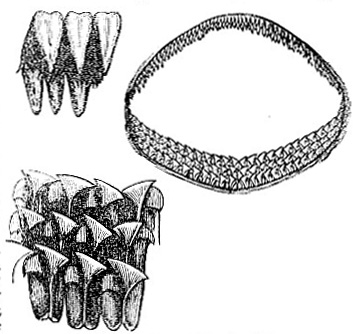1902 Encyclopedia > Shark > Rhinidon typicus. Greenland Shark. Spinous Shark.
A shark similar in many points to the basking shark (which it exceeds in size), and an inhabitant of the Indo-Pacific Ocean, is Rhinidon typicus. In fact, so far as our present knowledge goes, it is the largest of all sharks, as it Is known to exceed a length of 50 feet, but it is stated to attain that of 70. The captures of only a few specimens are on record, viz., one at the Cape of Good Hope, one or two near the "chagrin," one on the coast of California, and one (quite recently) on the coast of Peru. The snout is extremely short, broad, and flat, with the mouth and nostrils placed at its extremity; the gill-openings very wide, and the eye very small. The teeth are, as in the basking shark, extremely very small and numerous, conical in shape. No opportunity should be lost of obtaining exact information on this shark.

Fig. 14 -- Greenland Shark (Laemargus borealis)
The Greenland Shark (Laemargus borealis) belongs to the same family as the spiked dog-fish, but grows to a much larger size, specimens 15 feet long being frequently met with. The two dorsal fins are small and destitute of spines.

Fig. 15 -- Dentition of Greenland Shark
The teeth in the upper jaw are small, narrow, conical in shape; those of the lower flat, arranged in several series, one on the top of the other, so that only the uppermost forms the sharp dental edge of the jaw. The points of these lower teeth are so much turned aside that the inner margin only enters the dental edge. The Greenland shark is an inhabitant of the Arctic regions, sometimes straying to the latitudes of Great Britain and of Cape Cod in the western Atlantic; it is one of the greatest enemies of the whale, which is often found with large pieces bitten out of the tail by this shark. Its voracity is so great that, as Scoresby tells us, it is absolutely fearless in the presence of man whilst engaged in feeding on the carcase of a whale, and that it will allow itself to be stabbed with a lance or knife without being driven away.
The Spinous Shark (Echinorhinus spinosus) is readily recognized by the short bulky form of its body, its short tail and the large round bony tubercles which are scattered all over its body, each of which is raised in the middle into a pointed conical spine more frequently in the Mediterranean, it has been found also not very rarely on the English coasts and near the Cape of Good Hope. It is always living on the ground, and probably descends to some depth. It does not seem to exceed a length of 10 feet.
Read the rest of this article:
"Shark" Article - Table of Contents
|

